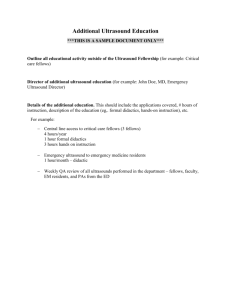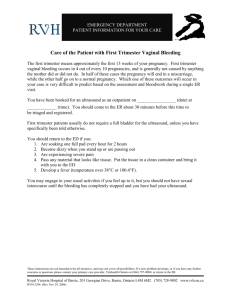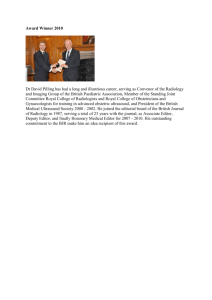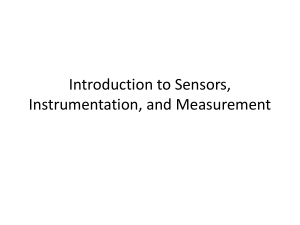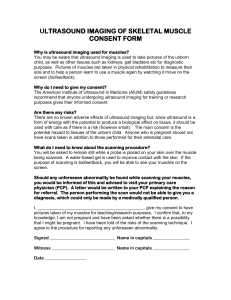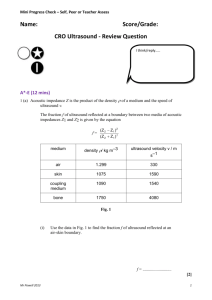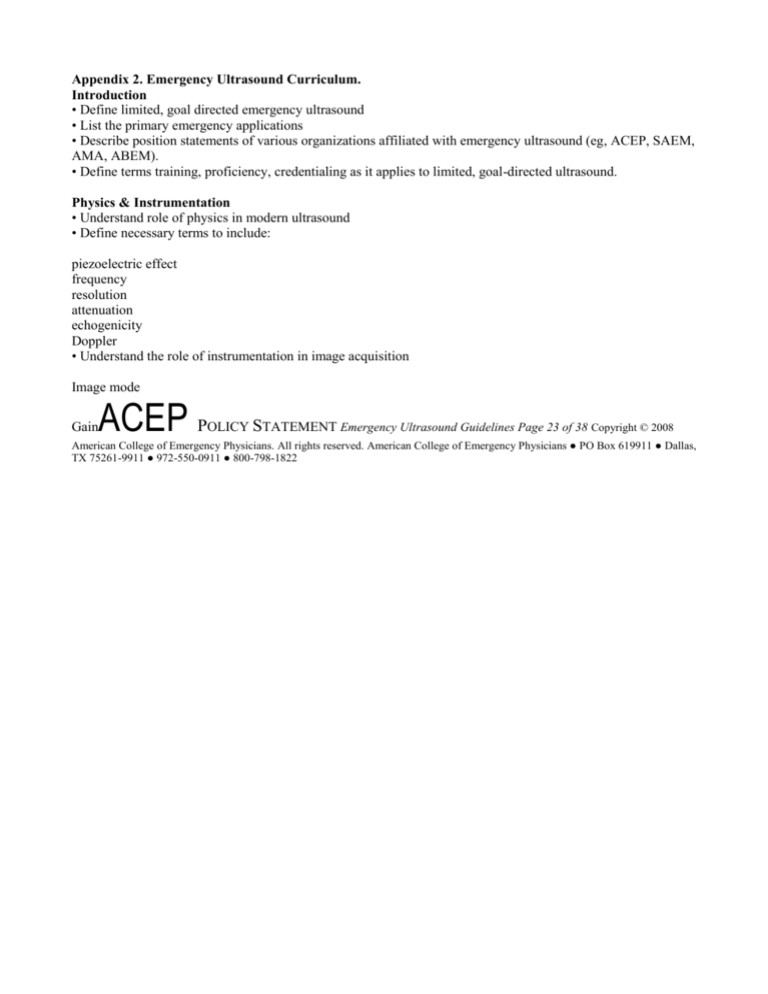
Appendix 2. Emergency Ultrasound Curriculum.
Introduction
• Define limited, goal directed emergency ultrasound
• List the primary emergency applications
• Describe position statements of various organizations affiliated with emergency ultrasound (eg, ACEP, SAEM,
AMA, ABEM).
• Define terms training, proficiency, credentialing as it applies to limited, goal-directed ultrasound.
Physics & Instrumentation
• Understand role of physics in modern ultrasound
• Define necessary terms to include:
piezoelectric effect
frequency
resolution
attenuation
echogenicity
Doppler
• Understand the role of instrumentation in image acquisition
Image mode
Gain
ACEP P
OLICY STATEMENT Emergency Ultrasound Guidelines Page 23 of 38 Copyright © 2008
American College of Emergency Physicians. All rights reserved. American College of Emergency Physicians ● PO Box 619911 ● Dallas,
TX 75261-9911 ● 972-550-0911 ● 800-798-1822
Time gain compensation
Focus
Dynamic range
Probe types
• Understand types of ultrasound artifacts and their role in image acquisition
Reverberation
Side lobe
Mirror
Shadowing
Enhancement
Ring-down
Trauma
• Describe the indications, clinical algorithms, and limitations of bedside ultrasound in blunt and penetrating
thoracoabdominal trauma.
• Define the relevant local anatomy including the liver, spleen, kidneys, bladder, uterus, pericardium, and lung
bases.
• Understand the standard ultrasound protocol required when evaluating for hemoperitoneum, hemopericardium,
hemothorax, and pneumothorax.
• Recognize the relevant focused findings and pitfalls related to the detection of hemoperitoneum,
hemopericardium, and hemothorax.
• Describe how volume status can be evaluated and monitored by evaluating left ventricular function and
inferior vena cava compliance.
First-Trimester Pregnancy
• Describe the relevant local anatomy including the uterus, cervix, adnexa, bladder and cul-de-sac.
• Describe the indications and limitations of focused sonography in first-trimester pregnancy pain and bleeding.
• Understand the standard ultrasound protocol including transabdominal and endovaginal views when performing
focused pelvic ultrasound in early pregnancy.
• Understand the role of ultrasound and quantitative b-hCG in a clinical algorithm for first-trimester pregnancy
pain and bleeding.
• Understand the differential diagnosis of early pregnancy including intrauterine pregnancy, embryonic demise,
molar pregnancy, ectopic pregnancy, and indeterminate classes.
• Recognize the relevant focused findings and pitfalls when evaluating for early intrauterine pregnancy and ectopic
pregnancy.
Early embryonic structures
Location of embryonic structures in pelvis
Findings of ectopic pregnancy
Pseudogestational sac
Adnexal masses
ACEP P
OLICY STATEMENT Emergency Ultrasound Guidelines Page 24 of 38 Copyright
© 2008 American College of Emergency Physicians. All rights reserved. American College of Emergency Physicians ● PO Box 619911 ●
Dallas, TX 75261-9911 ● 972-550-0911 ● 800-798-1822
Abdominal Aortic Aneurysm
• Describe indications and limitations of focused ultrasound in the evaluation of abdominal aortic aneurysms.
• Define the local relevant anatomy including the aorta with major branches, inferior vena cava, and vertebral
bodies.
• Understand the standard ultrasound protocol required when evaluating for abdominal aortic aneurysms.
• Recognize the relevant focused findings and pitfalls when evaluating for abdominal aortic aneurysms.
• Types of aneurysms
• Measurement technique
Echocardiography
• Describe the indications and limitations of focused emergency echocardiography.
• Define the relevant cardiac anatomy including cardiac chambers, valves, pericardium, and aorta.
• Understand the standard ultrasound windows (subcostal, parasternal, and apical) and planes (four chamber, long
and short axis) necessary to perform focused echocardiography when evaluating for cardiac activity and
pericardial effusions.
• Recognize the relevant focused findings to detect cardiac activity and pericardial effusions with or without
tamponade.
• Estimate qualitative left ventricular function.
• Estimation of central venous pressure through examination of inferior vena cava compliance.
• Understand how ultrasound can allow the examiner to estimate cardiac function and central venous pressure to
guide resuscitation in patients with cardiopulmonary instability.
• Recognize a dilated aortic root and/or descending thoracic aorta. Understand clinical relevance and potential
pitfalls.
Biliary Tract
• Describe the indications and limitations of focused biliary tract ultrasound.
• Define the relevant local anatomy including the gallbladder, portal triad, inferior vena cava, and liver.
• Understand the standard ultrasound protocol when performing focused biliary ultrasound.
• Recognize the relevant focused findings and pitfalls when evaluating for cholelithiasis and cholecystitis.
Urinary Tract Ultrasound
• Describe the indications and limitations of focused urinary tract ultrasonography.
• Define the relevant local anatomy including the kidneys and collecting systems, bladder, liver, and spleen.
• Understand the standard ultrasound protocol when performing focused urinary tract ultrasound.
• Recognize the relevant focused findings and pitfalls when evaluating for hydronephrosis, renal calculi, renal
masses, and bladder size.
ACEP P
OLICY STATEMENT Emergency Ultrasound Guidelines Page 25 of 38 Copyright © 2008 American
College of Emergency Physicians. All rights reserved. American College of Emergency Physicians ● PO Box 619911 ● Dallas, TX 752619911 ● 972-550-0911 ● 800-798-1822
Deep Venous Thrombosis
• Describe the indications and limitations of focused ultrasound for the detection of deep venous thrombosis.
• Understand the standard ultrasound protocol when performing a focused exam for the detection of deep venous
thrombosis of the upper and lower extremities.
Vessel identification
Compression
Augmentation
• Define the relevant local anatomy associated with ultrasonic detection of deep venous thrombosis in the upper
and lower extremities.
Develop an understanding of Doppler physics and instrumentation to include: Color Doppler
Power Doppler Imaging
• Recognize the relevant focused findings and pitfalls when evaluating for deep venous thrombosis.
Soft Tissue & Musculoskeletal
• Describe the indications and limitations of focused ultrasound of soft tissue and musculoskeletal structures.
• Define the relevant local anatomy associated with ultrasonic evaluation of soft tissue and musculoskeletal
structures to include:
Skin
Soft-tissue
Bones
Muscle
Tendon
Lymph Nodes
• Recognize the relevant focused findings and pitfalls when evaluating of the following:
Soft Tissue Infections
Abscess versus Cellulitis
Foreign Body Location and Removal
Fractures
Tendon injury (laceration, rupture)
Joint Identification
Upper extremity
Lower extremity
Subcutaneous Fluid Collection Identification
Thoracic Ultrasound
• Describe the indications and limitations of focused ultrasound of thorax.
• Define the relevant local anatomy associated with ultrasonic evaluation of thoracic structures.
• Understand the standard ultrasound protocol when performing a focused exam for the detection of:
Pleural effusion
Pneumothorax
• Recognize the relevant focused findings and pitfalls when evaluating for thoracic pathology
ACEP P
OLICY STATEMENT Emergency Ultrasound Guidelines Page 26 of 38 Copyright © 2008 American
College of Emergency Physicians. All rights reserved. American College of Emergency Physicians ● PO Box 619911 ● Dallas, TX 752619911 ● 972-550-0911 ● 800-798-1822
Ocular Ultrasound
• Describe the indications and limitations of focused ultrasound of the ocular structures and orbit.
• Define the relevant local anatomy associated with ultrasonic evaluation of eye and orbit structures.
• Understand the standard ultrasound protocol when performing a focused exam for the detection of:
posterior chamber hemorrhage
retinal detachment
Other structural disruption
• Recognize the relevant focused findings and pitfalls when evaluating for ocular pathology.
Procedural Ultrasound
• Describe the indications and limitations when using ultrasound to assist in bedside procedures.
• Understand the 2D approaches of transverse and longitudinal approaches to procedural guidance with their
advantages and disadvantages.
• Define the relevant local anatomy for the particular application.
• Understand the standard protocols when using ultrasound to assist in procedures. These procedures may include:
Vascular access-central and peripheral
Pericardiocentesis
Paracentesis
Thoracentesis
Foreign body detection removal
Bladder aspiration
Arthrocentesis
Pacemaker placement and capture
Abscess identification and drainage
• Recognize the relevant focused finding when performing ultrasound for procedural assistance.

![Jiye Jin-2014[1].3.17](http://s2.studylib.net/store/data/005485437_1-38483f116d2f44a767f9ba4fa894c894-300x300.png)
